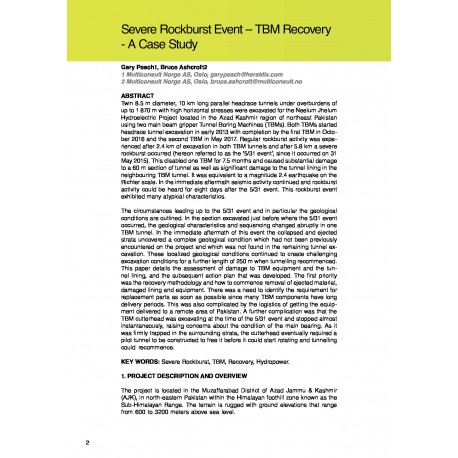Cart
0
0
No document
0,00 €
Total
Document successfully added to your shopping cart
Quantity
Total
There are 0 items in your cart.
There is 1 item in your cart.
Total documents
Total shipping
To be determined
Total
Search & filter
Search for a publication
Search & filter
Viewed documents
Severe Rockburst Event – TBM Recovery - A Case Study
1418_severe_rockburst_event_–_tb
Twin 8.5 m diameter, 10 km long parallel headrace tunnels under overburdens of up to 1 870 m with high horizontal stresses were excavated for the Neelum Jhelum Hydroelectric Project located in the Azad Kashmir region of northeast Pakistan using two main beam gripper Tunnel Boring Machines (TBMs). Both TBMs started headrace tunnel excavation in early 2013 with completion by the first TBM in October 2016 and the second TBM in May 2017. Regular rockburst activity was experienced after 2.4 km of excavation in both TBM tunnels and after 5.8 km a severe rockburst occurred (hereon referred to as the ‘5/31 event’, since it occurred on 31 May 2015). This disabled one TBM for 7.5 months and caused substantial damage to a 60 m section of tunnel as well as significant damage to the tunnel lining in the neighbouring TBM tunnel. It was equivalent to a magnitude 2.4 earthquake on the Richter scale. In the immediate aftermath seismic activity continued and rockburst activity could be heard for eight days after the 5/31 event. This rockburst event exhibited many atypical characteristics.The circumstances leading up to the 5/31 event and in particular the geological conditions are outlined. In the section excavated just before where the 5/31 event occurred, the geological characteristics and sequencing changed abruptly in one TBM tunnel. In the immediate aftermath of this event the collapsed and ejected strata uncovered a complex geological condition which had not been previously encountered on the project and which was not found in the remaining tunnel excavation. These localized geological conditions continued to create challenging excavation conditions for a further length of 250 m when tunnelling recommenced. This paper details the assessment of damage to TBM equipment and the tunnel lining, and the subsequent action plan that was developed. The first priority was the recovery methodology and how to commence removal of ejected material, damaged lining and equipment. There was a need to identify the requirement for replacement parts as soon as possible since many TBM components have long delivery periods. This was also complicated by the logistics of getting the equipment delivered to a remote area of Pakistan. A further complication was that the TBM cutterhead was excavating at the time of the 5/31 event and stopped almost instantaneously, raising concerns about the condition of the main bearing. As it was firmly trapped in the surrounding strata, the cutterhead eventually required a pilot tunnel to be constructed to free it before it could start rotating and tunnelling could recommence. Severe Rockburst, TBM, Recovery, Hydropower.The project is located in the Muzaffarabad District of Azad Jammu & Kashmir (AJK), in north-eastern Pakistan within the Himalayan foothill zone known as the Sub-Himalayan Range. The terrain is rugged with ground elevations that range from 600 to 3200 meters above sea level.




